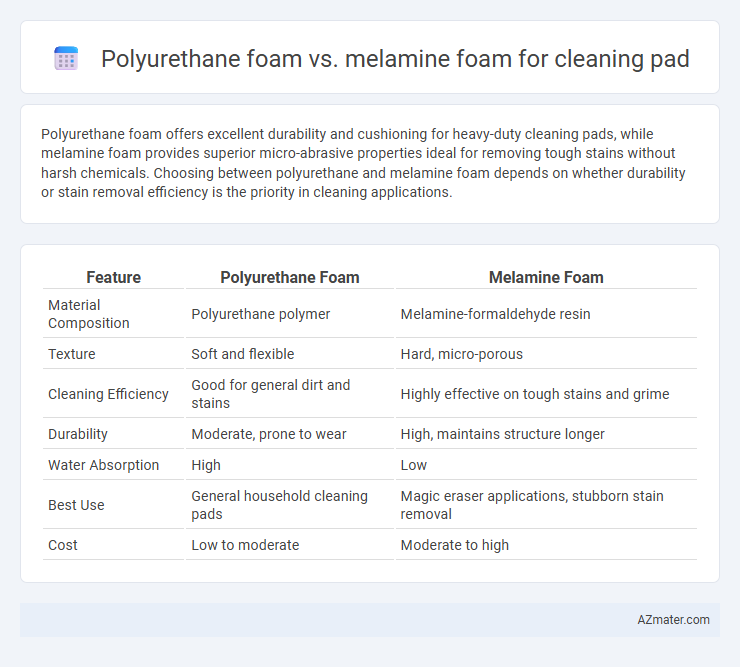Polyurethane foam offers excellent durability and cushioning for heavy-duty cleaning pads, while melamine foam provides superior micro-abrasive properties ideal for removing tough stains without harsh chemicals. Choosing between polyurethane and melamine foam depends on whether durability or stain removal efficiency is the priority in cleaning applications.
Table of Comparison
| Feature | Polyurethane Foam | Melamine Foam |
|---|---|---|
| Material Composition | Polyurethane polymer | Melamine-formaldehyde resin |
| Texture | Soft and flexible | Hard, micro-porous |
| Cleaning Efficiency | Good for general dirt and stains | Highly effective on tough stains and grime |
| Durability | Moderate, prone to wear | High, maintains structure longer |
| Water Absorption | High | Low |
| Best Use | General household cleaning pads | Magic eraser applications, stubborn stain removal |
| Cost | Low to moderate | Moderate to high |
Introduction to Cleaning Pad Materials
Polyurethane foam and melamine foam are two common materials used in cleaning pads, each with distinct properties suitable for different cleaning tasks. Polyurethane foam is durable, flexible, and absorbent, making it ideal for scrubbing and wiping surfaces without scratching. Melamine foam features a unique microstructure that acts like ultra-fine sandpaper, effectively removing dirt and stains from various surfaces with minimal effort.
What is Polyurethane Foam?
Polyurethane foam is a versatile polymer material commonly used in cleaning pads due to its durability, flexibility, and excellent absorption properties. It features an open-cell structure that allows effective trapping of dirt and liquids, making it ideal for scrubbing and wiping surfaces without damage. Compared to melamine foam, polyurethane foam offers higher resistance to tearing and chemical wear, enhancing its longevity in intensive cleaning applications.
What is Melamine Foam?
Melamine foam is a highly porous, lightweight cleaning material known for its micro-abrasive properties, making it effective at removing stubborn stains and dirt without harsh chemicals. Unlike polyurethane foam, which is flexible and primarily used for cushioning, melamine foam acts like a very fine sandpaper on a microscopic level, ideal for cleaning delicate surfaces and hard-to-reach areas. Its unique structure enables it to trap and lift particles efficiently, making it a preferred choice for detailed cleaning pads.
Key Differences in Material Structure
Polyurethane foam features an open-cell structure that provides high durability and excellent abrasion resistance, making it ideal for heavy-duty cleaning tasks. Melamine foam consists of a unique, fine, open-cell network made from a thermoset polymer, which delivers superior micro-abrasion for removing tough stains without chemical agents. The distinct material composition results in polyurethane foam being more resilient and flexible, while melamine foam offers enhanced precision cleaning with its ultra-fine, rigid cell structure.
Cleaning Efficiency Comparison
Polyurethane foam exhibits superior cleaning efficiency on oily and greasy surfaces due to its open-cell structure, which traps dirt particles effectively, while melamine foam excels at removing dry stains and fine dust thanks to its micro-structured abrasive properties. The density and porosity of polyurethane foam allow better absorption of liquids and detergents, enhancing grease removal, whereas melamine foam functions like ultra-fine sandpaper, ideal for tough stains and grime without requiring additional cleaning agents. Performance evaluations show polyurethane foam pads maintain durability in heavy-duty cleaning, while melamine foam pads are preferred for delicate surfaces requiring scratch-free stain removal.
Durability and Longevity
Polyurethane foam cleaning pads offer superior durability due to their dense cell structure, which resists tearing and deformation during heavy scrubbing tasks. Melamine foam, while effective in removing stains through micro-abrasion, tends to degrade faster with frequent use, limiting its longevity. Choosing polyurethane foam ensures a longer-lasting cleaning pad suitable for repetitive and intensive cleaning applications.
Safety and Chemical Resistance
Polyurethane foam cleaning pads offer excellent durability and moderate chemical resistance, making them suitable for general cleaning tasks but may degrade when exposed to strong acids or solvents. Melamine foam, known for its micro-porous structure, provides superior safety with non-toxic, hypoallergenic properties and exceptional resistance to harsh chemicals and high temperatures. Choosing between the two depends on the cleaning environment; melamine foam excels in sensitive or chemical-prone settings, while polyurethane foam serves well in less chemically aggressive conditions.
Environmental Impact and Sustainability
Polyurethane foam cleaning pads have a higher environmental footprint due to their petroleum-based composition and longer degradation time, leading to increased landfill waste. Melamine foam, often marketed as a biodegradable alternative, breaks down more quickly and reduces landfill impact but can still release formaldehyde during production. Sustainable cleaning pads increasingly favor melamine foam for its lower durability cycle and improved recyclability, although innovations in bio-based polyurethane foams are emerging to balance performance and eco-friendliness.
Cost and Availability
Polyurethane foam cleaning pads typically offer a lower cost and greater availability due to widespread manufacturing and diverse applications in households and industries. Melamine foam pads, while often more expensive per unit, provide superior cleaning efficiency and stain removal but have a more limited supply chain primarily in specialty cleaning markets. Businesses and consumers prioritize polyurethane foam for budget-friendly, bulk purchases, whereas melamine foam is chosen for targeted, high-performance cleaning despite higher costs.
Choosing the Right Foam for Your Cleaning Needs
Polyurethane foam offers excellent durability and absorbs liquids effectively, making it ideal for heavy-duty cleaning tasks and scrubbing surfaces with stubborn dirt and grime. Melamine foam, known for its micro-porous structure, acts like a very fine abrasive without scratching, perfect for removing stains on delicate surfaces such as walls, shoes, and appliances. Selecting the right foam depends on the cleaning challenge: choose polyurethane for tough grime and melamine for gentle, residue-free cleaning on sensitive materials.

Infographic: Polyurethane foam vs Melamine foam for Cleaning pad
 azmater.com
azmater.com